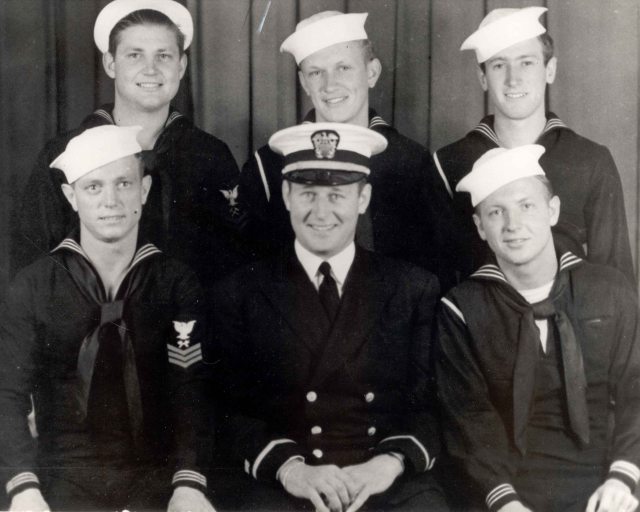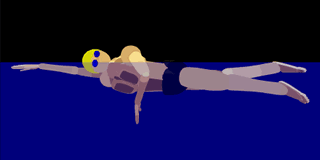|
Combat Sidestroke
Combat side stroke or CSS is a variation of the side stroke that was developed by and taught to the United States Navy SEALs. The Combat Swimmer Stroke was developed for the United States Navy Seals by Former Navy SEAL Stew Smith (CSCS) and Terry Laughlin of Total Immersion Swimming. The combat side stroke is a relaxing and very efficient swim stroke that is an updated version of the traditional sidestroke. The CSS is a mix of sidestroke, front crawl, and breaststroke. The combat side stroke allows the swimmer to swim more efficiently and reduces the body's profile in the water to be less likely to be seen during combat operations if surface swimming is required. The concept of CSS has been that it can be used with or without wearing swim fins (flippers), the only difference being that when wearing swim fins the swimmer's legs will always be kicking in the regular flutter kick The flutter kick is a kicking movement used in both swimming and calisthenics. Swimming In swi ... [...More Info...] [...Related Items...] OR: [Wikipedia] [Google] [Baidu] |
Side Stroke
The sidestroke is a swimming stroke, so named because the swimmer lies on one's side with asymmetric arm and leg motion. It is helpful as a lifesaving technique and is often used for long-distance swimming. The sidestroke allows the swimmer increased endurance because instead of working both arms and legs simultaneously in the same way, the side stroke uses them simultaneously but differently. A swimmer tired of exercising one side can turn over and use the other, the change of action helping the limbs to recover. The hands act like oars, and do not waste any power by oblique action. In ordinary swimming on the right side, the left arm moves gently in the water, almost at rest. Then, when the used arm becomes tired, the swimmer turns on the other side, and the left arm works while the right arm rests. The legs move in opposite directions with legs bent, and straighten as they come together. The kicking motion is exaggerated and slow, opening the legs wide to provide more thrust ra ... [...More Info...] [...Related Items...] OR: [Wikipedia] [Google] [Baidu] |
United States Navy SEALs
The United States Navy Sea, Air, and Land (SEAL) Teams, commonly known as Navy SEALs, are the United States Navy's primary special operations force and a component of the United States Naval Special Warfare Command. Among the SEALs' main functions are conducting small-unit special operation missions in maritime, jungle, urban, arctic, mountainous, and desert environments. SEALs are typically ordered to capture or kill high-level targets, or to gather intelligence behind enemy lines. SEAL team personnel are hand-selected, highly trained, and highly proficient in unconventional warfare (UW), direct action (DA), and special reconnaissance (SR), among other tasks like sabotage, demolition, intelligence gathering, and hydrographic reconnaissance, training, and advising friendly militaries or other forces. All active SEALs are members of the U.S. Navy. History Origins Although not formally founded until 1962, the modern-day U.S. Navy SEALs trace their roots to World War II. The U ... [...More Info...] [...Related Items...] OR: [Wikipedia] [Google] [Baidu] |
Terry Laughlin
Terrence James Laughlin (25 March 1951 – 20 October 2017), was an American swimming coach and founder of Total Immersion, a popular swimming technique that emphasizes form before speed. He also became a best-selling author and the producer of swimming videos that drew millions of views. Birth and education Laughlin (pronounced LOCK-lin) was born March 25, 1951, in Brooklyn, New York to electrician John Laughlin and the former Patricia O’Toole, who worked in a doctor's office. The oldest of six children, he grew up on Long Island, in Williston Park. He graduated from St. Mary’s High School, a Catholic high school in Manhasset, New York, and then St. John's University in Queens. He majored in political science and graduated in 1972. Student swimmer His swimming abilities as a young student growing up on Long Island were not impressive. He was cut from his grammar school swim team, but still aspired to race competitively. After swimming two summers in pursuit of his Red ... [...More Info...] [...Related Items...] OR: [Wikipedia] [Google] [Baidu] |
Sidestroke
The sidestroke is a swimming stroke, so named because the swimmer lies on one's side with asymmetric arm and leg motion. It is helpful as a lifesaving technique and is often used for long-distance swimming. The sidestroke allows the swimmer increased endurance because instead of working both arms and legs simultaneously in the same way, the side stroke uses them simultaneously but differently. A swimmer tired of exercising one side can turn over and use the other, the change of action helping the limbs to recover. The hands act like oars, and do not waste any power by oblique action. In ordinary swimming on the right side, the left arm moves gently in the water, almost at rest. Then, when the used arm becomes tired, the swimmer turns on the other side, and the left arm works while the right arm rests. The legs move in opposite directions with legs bent, and straighten as they come together. The kicking motion is exaggerated and slow, opening the legs wide to provide more thrust ra ... [...More Info...] [...Related Items...] OR: [Wikipedia] [Google] [Baidu] |
Front Crawl
The front crawl or forward crawl, also known as the Australian crawl or American crawl, is a swimming stroke usually regarded as the fastest of the four front primary strokes. As such, the front crawl stroke is almost universally used during a freestyle swimming competition, and hence freestyle is used metonymically for the front crawl. It is one of two long axis strokes, the other one being the backstroke. Unlike the backstroke, the breaststroke, and the butterfly stroke, the front crawl is not regulated by World Aquatics. Hence, in "freestyle" competitive swimming events, any stroke or combination of strokes is permissible. This style is sometimes referred to as the Australian crawl although this can sometimes refer to a more specific variant of front crawl. The face-down swimming position allows for a good range of motion of the arm in the water, as compared to the ''backstroke'', where the hands cannot be moved easily along the back of the spine. The above-water recovery of ... [...More Info...] [...Related Items...] OR: [Wikipedia] [Google] [Baidu] |
Breaststroke
Breaststroke is a human swimming, swimming style in which the swimmer is on their chest and the torso does not rotate. It is the most popular recreational style due to the swimmer's head being out of the water a large portion of the time, and that it can be swum comfortably at slow speeds. In most swimming classes, beginners learn either the breaststroke or the freestyle (front crawl) first. However, at the competitive level, swimming breaststroke at speed requires endurance and strength comparable to other strokes. Some people refer to breaststroke as the "frog" stroke, as the arms and legs move somewhat like a frog swimming in the water. The stroke itself is the slowest of any competitive strokes and is thought to be the oldest of all swimming strokes. Speed and ergonomics Breaststroke is the slowest of the four official styles in swimming (sport), competitive swimming. The fastest breaststrokers can swim about 1.70 meters (~5.6 feet) per second. It is sometimes the harde ... [...More Info...] [...Related Items...] OR: [Wikipedia] [Google] [Baidu] |
Swimfin
Swimfins, swim fins, diving fins, or flippers are finlike accessories worn on the feet, legs or hands and made from rubber, plastic, carbon fiber or combinations of these materials, to aid movement through the water in water sports activities such as swimming, bodyboarding, bodysurfing, float-tube fishing, kneeboarding, riverboarding, scuba diving, snorkeling, spearfishing, underwater hockey, underwater rugby and various other types of underwater diving. Swimfins help the wearer to move through water more efficiently, as human feet are too small and inappropriately shaped to provide much thrust, especially when the wearer is carrying equipment that increases hydrodynamic drag. Very long fins and monofins used by freedivers as a means of underwater propulsion do not require high-frequency leg movement. This improves efficiency and helps to minimize oxygen consumption. Short, stiff-bladed fins are effective for short bursts of acceleration and maneuvering, and are useful fo ... [...More Info...] [...Related Items...] OR: [Wikipedia] [Google] [Baidu] |
Flutter Kick
The flutter kick is a kicking movement used in both swimming and calisthenics. Swimming In swimming, the flutter kick refers to an alternating up and down movement of the legs. It is seen in front crawl and backstroke. The downbeat refers to the portion of each individual kick where the leg moves downwards, and the upbeat refers to the repositioning of the leg upwards. In front crawl, the flutter kick is sometimes referred to as the front crawl kick, and in backstroke it is sometimes called the backstroke kick. Phases In front crawl, the downbeat of each kick is initiated by the simultaneous action of bending the knee and flexing the hip to push down on the water with the thigh. The knee then extends forcefully, pushing the lower leg against the water until the leg is straight. The ankle then extends, pushing the foot into the water until it is inline with the rest of the leg. When the knee extends for the downbeat, it also has the effect of lifting the thigh and initiating t ... [...More Info...] [...Related Items...] OR: [Wikipedia] [Google] [Baidu] |
Basic Underwater Demolitions/SEAL
The average member of the United States Navy's Sea, Air, Land Teams (SEALs) spends over a year in a series of formal training environments before being awarded the Special Warfare Operator Naval Rating and the Navy Enlisted Classification (NEC) O26A Combatant Swimmer (SEAL) or, in the case of commissioned naval officers, the designation 113X Special Warfare Officer. All Navy SEALs must attend and graduate from their rating's 24-week "A" School known as Basic Underwater Demolition/SEAL (BUD/S) school, a basic parachutist course and then the 26-week SEAL Qualification Training program. All sailors entering the SEAL training pipeline chosen by Naval Special Warfare Command must also attend the six-month SEAL specific Special Operations Tactical Medic course in Stennis, Mississippi, and subsequently earn the NEC SO-5393 Naval Special Warfare Medic before joining an operational Team. Once outside the formal schooling environment SEALs entering a new Team at the beginning of a ... [...More Info...] [...Related Items...] OR: [Wikipedia] [Google] [Baidu] |
Swimming Styles
Swimming is the self-propulsion of a person through water, such as saltwater or freshwater environments, usually for recreation, sport, exercise, or survival. Swimmers achieve locomotion by coordinating limb and body movements to achieve hydrodynamic thrust that results in directional motion. Newborns can instinctively hold their breath underwater and exhibit rudimentary swimming movements as part of a survival reflex. Swimming requires endurance, skill and efficient techniques to maximize speed and minimize energy consumption. Swimming is a popular activity and competitive sport where certain techniques are deployed to move through water. It offers numerous health benefits, such as strengthened cardiovascular health, muscle strength, and increased flexibility. It is suitable for people of all ages and fitness levels. Swimming is consistently among the top public recreational activities, and in some countries, swimming lessons are a compulsory part of the educational curriculum. ... [...More Info...] [...Related Items...] OR: [Wikipedia] [Google] [Baidu] |





